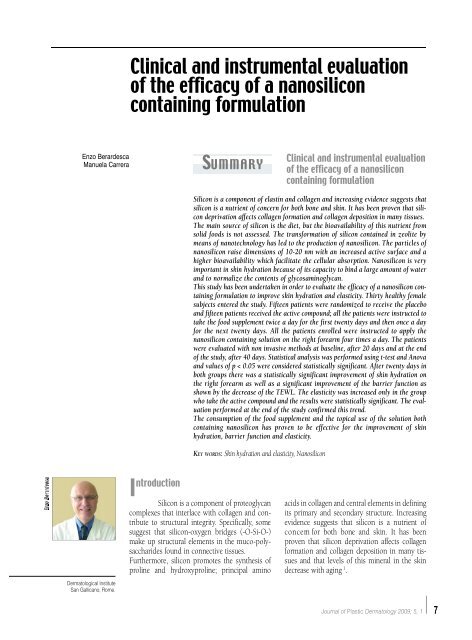Vol. 5, n. 1, January-March 2009 1th International ... - Salute per tutti
Vol. 5, n. 1, January-March 2009 1th International ... - Salute per tutti
Vol. 5, n. 1, January-March 2009 1th International ... - Salute per tutti
You also want an ePaper? Increase the reach of your titles
YUMPU automatically turns print PDFs into web optimized ePapers that Google loves.
Enzo Berardesca<br />
Manuela Carrera<br />
Dermatological Institute<br />
San Gallicano, Rome.<br />
Clinical and instrumental evaluation<br />
of the efficacy of a nanosilicon<br />
containing formulation<br />
SU M M A R Y<br />
I ntroduction<br />
Silicon is a component of pro t e o g l y c a n<br />
complexes that interlace with collagen and contribute<br />
to structural integrity. Specifically, some<br />
suggest that silicon-oxygen bridges (-O-Si-O-)<br />
make up structural elements in the muco-polysaccharides<br />
found in connective tissues.<br />
F u r t h e r m o re, silicon promotes the synthesis of<br />
p roline and hydro x y p roline; principal amino<br />
Clinical and instrumental evaluation<br />
of the efficacy of a nanosilicon<br />
containing formulation<br />
Silicon is a component of elastin and collagen and increasing evidence suggests that<br />
silicon is a nutrient of concern for both bone and skin. It has been proven that silicon<br />
deprivation affects collagen formation and collagen deposition in many tissues.<br />
The main source of silicon is the diet, but the bioavailability of this nutrient fro m<br />
solid foods is not assessed. The transformation of silicon contained in zeolite by<br />
means of nanotechnology has led to the production of nanosilicon. The particles of<br />
nanosilicon raise dimensions of 10-20 nm with an increased active surface and a<br />
higher bioavailability which facilitate the cellular absorption. Nanosilicon is very<br />
important in skin hydration because of its capacity to bind a large amount of water<br />
and to normalize the contents of glycosaminoglycan.<br />
This study has been undertaken in order to evaluate the efficacy of a nanosilicon containing<br />
formulation to improve skin hydration and elasticity. Thirty healthy female<br />
subjects entered the study. Fifteen patients were randomized to receive the placebo<br />
and fifteen patients received the active compound; all the patients were instructed to<br />
take the food supplement twice a day for the first twenty days and then once a day<br />
for the next twenty days. All the patients enrolled were instructed to apply the<br />
nanosilicon containing solution on the right forearm four times a day. The patients<br />
were evaluated with non invasive methods at baseline, after 20 days and at the end<br />
of the study, after 40 days. Statistical analysis was <strong>per</strong>formed using t-test and Anova<br />
and values of p < 0.05 were considered statistically significant. After twenty days in<br />
both groups there was a statistically significant improvement of skin hydration on<br />
the right forearm as well as a significant improvement of the barrier function as<br />
shown by the decrease of the TEWL. The elasticity was increased only in the group<br />
who take the active compound and the results were statistically significant. The evaluation<br />
<strong>per</strong>formed at the end of the study confirmed this trend.<br />
The consumption of the food supplement and the topical use of the solution both<br />
containing nanosilicon has proven to be effective for the improvement of skin<br />
hydration, barrier function and elasticity.<br />
KE Y W O R D S: Skin hydration and elasticity, Nanosilicon<br />
acids in collagen and central elements in defining<br />
its primary and secondary structure. Incre a s i n g<br />
evidence suggests that silicon is a nutrient of<br />
c o n c e rn for both bone and skin. It has been<br />
p roven that silicon deprivation affects collagen<br />
formation and collagen deposition in many tissues<br />
and that levels of this mineral in the skin<br />
d e c rease with aging 1 .<br />
Journal of Plastic Dermatology <strong>2009</strong>; 5, 1 7

















